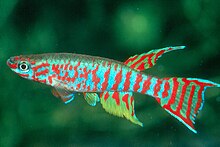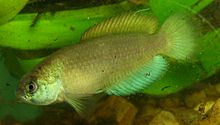| Aplocheiloidei Temporal range: | |
|---|---|
 | |
| Aphyosemion elberti | |
 | |
| Austrolebias quirogai | |
| Scientific classification | |
| Domain: | Eukaryota |
| Kingdom: | Animalia |
| Phylum: | Chordata |
| Class: | Actinopterygii |
| Order: | Cyprinodontiformes |
| Suborder: | Aplocheiloidei Parenti, 1981 [1] |
Aplocheiloidei is a suborder of the order Cyprinodontiformes consisting of three families which are commonly known as killifishes.
